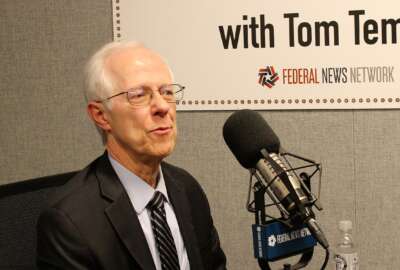Fiscal 2024 starts with a CR, but contractors still have lots of opportunities
Fiscal 2024 started off like most fiscal years, with a Continuing Resolution. The government is still spending, and contractors have lots of opportunities. For the...
Fiscal 2024 started off like most fiscal years, with a Continuing Resolution. The government is still spending, and contractors have lots of opportunities. For the top opportunities in the year ahead, Federal Drive with Tom Temin spoke with Bloomberg Government Senior Data Analyst Paul Murphy.
Interview Transcript:
Tom Temin And many of the opportunities that you point out are actually existing programs, existing contracting vehicles that are not really necessarily impeded by the fact that there’s a C.R., Fair to say.
Paul Murphy Yeah, I think that is fair to say. That’s actually one of the themes you kind of anticipate in one of my responses. What we’re seeing especially are these multiple iteration contracts. You know, just a few Alliant 3, SUP6, MES2, IH2. I mean, I think the agencies are showing a commitment to established contracting procedures and contracts that work, contracts that have a history of delivering and are to some degree, you know, kind of protest free. You know, we’ve seen delays with significant opportunities this year. You know on Polaris on COSP-4 for and Oasis+ got hit with a protest in September. So a lot of these self-scoring opportunities are getting hit with protest I think in part because they’re so big and they’re really market defining that companies feel that, you know, they have nothing to lose by protesting and they’re having actually some success with it.
Tom Temin Now Alliant 3 unrestricted the GSA’s big GWAC with an estimated value per Bloomberg of $75 billion. What about if you’re not on Alliant 3 and that’s a general services type of IT contract, then what are your prospects?
Paul Murphy Well, you know, they added another $25 billion to the ceiling on Alliant last year and probably a good thing they didn’t have because it’s been delayed along with a couple of the other is you know, everybody went back to the drawing board to make sure their T’s were crossed and their eyes were dotted after the Polaris protest. But it’s a very broad ranging contract. It’s, you know, $75 billion ceiling is huge, although technically it doesn’t have a fixed ceiling so technically there’s no ceiling. GSA got special dispensation. But based on the pattern of spending over the last several years, we see one of a handful of GWACs that are really market defining. And, you know, if you’re a small well, this is unrestricted, but you know, for the others that have, you know, small business carve outs, if you’re, you know, small midsize firms, you either want to have a slice of this action or you want to be part of teams that, you know, have access to these contract vehicles.
Tom Temin So if I’m a contractor, I’m looking ahead to 2024. There’s all of these vehicles, the top ten that you mentioned or, you know, well over $100 billion in ceiling value. And they have different areas that they cover. What should I be thinking about in terms of themes for the government? I mean, the way I look at it, spending breaks down on two basic buckets. One is highly mission related and the other is all of the administrative clerical housekeeping, just keeping the agency running. Types of services, mostly, some products that are nevertheless big business. Also.
Paul Murphy If you would permit me, let me just back up a second and address this issue of the CR. What we’re noticing is kind of an increasingly sluggish pace of acquisition development over the last year. It started with debt breach in late May and June. That got resolved. But then we lurched into the budget debate in September. You know, there was the threat of a shutdown. We finally got to see a 45 day CR and I think this is introducing an uncertainty factor with agencies who are reluctant to commit to new awards without full appropriation. For example, you know, the Defense Threat Reduction Agency recently told interested bidders that they’d proceed with their general acquisition process for three and a half billion dollar opportunity to prevent the deployment of weapons of mass destruction. And DTRA said the Defense Threat Reduction Agency sponsoring the they said that, you know, we’re going to go ahead with the acquisition, but not with a final RFP until we’re sure we have funds. And so right now, they push the RFP into the next year, and they’re just waiting to see what kind of resolution there is in Congress. So I think one of the things companies can expect in their planning process is a certain amount of delay. Hopefully it doesn’t result in a shutdown where, you know, it has other kinds of implications, economic and employment, so forth. But right now, we’re kind of in a holding pattern. Funding is locked in to rates based on last year’s level. So in some sense, you know, things like Alliant 2 and SUP6 that would continue these opportunities is perhaps no reason to delay, you know, for budget reasons, the acquisition cycle. But as far as making new awards and these contracts, you know, there’ll be people using these contracts, agencies using these contracts will have their hands tied, you know, just like all the other agencies.
Tom Temin We’re speaking with Paul Murphy. He’s senior data analyst at Bloomberg Government. And so the themes this year.
Paul Murphy Transformation, the agencies, you know, we have about 40% of the opportunities are I.T. and they account for 70% of the dollars. So we’re seeing a lot of the latest technology be incorporated into a range of opportunities. You know AI, 5G, 6G. Quantum computing, cyber encryption, high speed network sensors, satellite communications. These are becoming integrated parts of a lot of opportunities. And it’s all kind of reflected in the grades that you saw with the release of the latest, you know, FITARA 16.0 report. Agencies are getting pretty good grades, by and large on IT this go around. They’re having trouble transitioning off of networks to the new telecommunications contract GSA is promoting. But otherwise, you know, IT is really getting baked into a lot of different even facilities management contracts.
Tom Temin What would be some good strategies then for contractors to pursue to try to keep the revenue levels up? Because we don’t know what the final spending levels will be. And there is still that prevailing Republican gambit to take the levels down a little bit. And that’s going to come out of procurement because they’re not going to lay off federal employees. So that’s not where the cost cutting will come. It’s likely to come from procurement.
Paul Murphy So those are the two big buckets of discretionary spending. But in theory, I mean, any government program that is directly or indirectly administered through, you know, contracts could be the spending on those programs could be affected. So what we’re recommending to our clients is, you know, you need market intel. You need to know are the agencies moving ahead with this procurement or are they not? You need to know specific terms from your contract, officer. You know, is your work essential or is it unessential? Are your employees going to be expected to come in on furlough or are they possibly essential? Is there money in the pipeline available to even pay? I mean some contract, big contracts, you know, defense contracts get advanced funding when they have to buy supplies or, you know, higher up to, you know, adding scientists to do some R&D. And some of these big contracts there’s already advanced funding. And so it’s really kind of a unique contract by contract agency by agency. You know, what’s essential, what’s not. A lot of the success in navigating these kind of monstrous waters over the next few weeks is going to be based on communications with contract officers, contract administers, watching the intelligence, seeing which steps the agencies are going to make, even as they express some uncertainty in the ultimate level of funding that they’re going to get.
Tom Temin Now, the continuing resolution at 45 days was a pretty long one, a month and a half, which takes a month and a half out of the time you would have to develop new programs once a final appropriation comes through, if it does, in fact, come through it after 45 days. So it sounds like because we don’t have a shutdown and therefore you can talk to the government, this would be a good time to get your government counterpart if you’re a contractor and have discussions about what you would like to launch as new once the new money comes through, use the fact that there’s no shutdown so that when the appropriations come through, you’re ready because it would be a shortened runway, if you will.
Paul Murphy Absolutely. And see if there’s any, you know, a sent money that’s deemed essential that can be obligated against your contracts that may have maybe it could be reprogramed or maybe it was there. Maybe it’s a multi-year contract, like a lot of R&D and construction contracts, you know, at multiple years. Some agencies like the Indian Health Service are actually, you know, funded for the next year. So there is, you know, money, some contracts available. I mean IHS has a big health modernization opportunities moving forward. So you need to understand every contract in your pipeline or every opportunity in your pipeline, every contract you hold, You know, what is the status of that and just, you know, run through all your contacts with the agencies to make sure that you have updated information and you’re constantly watching the intelligence. Yeah, I think that’s going to be, you know, the way it’s five.
Tom Temin Anything else we need to know?
Paul Murphy Well, two quick things. One is a lot of particularly the defense technology contracts are emphasizing global networks integration. A lot of these opportunities like Air Force mission partner, environmental Army TADs, they’re feeding into this JADC2 global network environment. The other thing is we’re seeing a lot of opportunities that we have increased ceilings like DHS PAX 3, IHT 2.0. They’re reconfiguring the contracts, they’re raising the ceiling, adding vendors.
Copyright © 2025 Federal News Network. All rights reserved. This website is not intended for users located within the European Economic Area.
Tom Temin is host of the Federal Drive and has been providing insight on federal technology and management issues for more than 30 years.
Follow @tteminWFED






